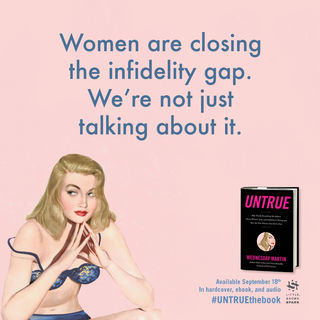Sex
Are Women Hungrier for Sex Than We Thought?
New research might tell us, once we figure out what it means.
Updated May 17, 2024 Reviewed by Ekua Hagan

Women's sexual behavior is changing. No doubt about that.
Many young women today in the developed West seem to favor hook-ups over dates. They watch online porn in greater numbers than ever before.
Women have become more active voyeurs in other ways as well. The Beatles drove their female admirers crazy without ever having to undress. But today's male entertainers now regularly strip down to their shorts, and their female fans expect them to be toned, well-muscled, and interestingly-tattooed.
In the '90s, Daphne Merkin shocked the world when she wrote in The New Yorker about liking to be spanked. But these days, every self-respecting sex toy shop in America has on hand a good supply of rope, wrist-cuffs, and floggers.
What's going on? Are we seeing a new era of female sexual empowerment and freedom? Or is this just consumer society's answer to its own self-induced erotic boredom?
Can We Strip Female Desire From Its Social Context?
To answer that question, it would be helpful if we had a firmer sense of what female sexuality is really all about. In recent years, the erotic version of Freud's famous question, "What does a woman really want?" is being asked more and more by sex researchers and anthropologists.
It's a hard question, though, since sexual behavior is so responsive to social context. To quote one anonymous respondent to a previous blog of mine on this site, “It’s a proven scientific fact that women base their decisions largely on what the majority chooses. Women are social creatures.”
Will we ever be able to understand female desire, stripped of its cultural setting? I doubt it. Social context has always been — and will always be — part of the picture. But that hasn't stopped sex researchers from trying to answer the question anyway.
Evidence From the Sex Lab
Some researchers have gone to the laboratory for answers. Like Masters and Johnson in the 1960s, sex scientists have closely observed individuals' genital reactions to visual and auditory erotic stimuli and studied how well these correlated with people's subjective response.
The results have been startling. When a man in the lab says something turns him on, his penis usually concurs. For women, it’s more complex.
Regardless of their sexual orientation, many women's genitals show arousal to video images of ANY kind of sex — straight sex, gay sex, or even bonobo sex, it doesn't matter — often without her having any idea her body is aroused.
Unfortunately, no one has any idea what this all means. Speculation runs in two completely opposite directions.
Say What?
On the one hand, people like sex educator Emily Nagoski argue that genital arousal in the absence of subjective excitement means very little. It's just a woman's sexual brain saying, "Oh, here's sex," in the same way she might say, "Oh, here's a restaurant."
Cultural critic Wednesday Martin draws the opposite conclusion. In her fascinating new book, Untrue: Why Nearly Everything We Believe About Women, Lust, and Infidelity Is Wrong and How the New Science Can Set Us Free, she argues that the new data suggest that women's desire is in fact stronger than men's. Journalist Daniel Bergner, who like Martin spent hours interviewing the researchers involved, concluded that the research shows women are "omnivorous."
Well, which is it? Female genital arousal as "Oh, here's a restaurant?" Or women as sexual omnivores who lust more than men do?
What you see in the data might depend on your agenda. Martin, like Bergner, wants to correct the traditional notion of the low-desire woman. Nagoski wants people to understand that women's personal feelings matter more than their signs of physical arousal.
But what do the research findings really mean? No one truly knows, since the data don't come with instructions.
Evidence From Other Cultures
Perhaps anthropology can help us here. Most experts agree that women's sexual behavior today is constrained by all sorts of cultural baggage accumulated over thousands of years of Western civilization. In Untrue, Martin argues that social changes in plow-based agricultural societies like our own have led to Western women getting the cultural equivalent of a clitoridectomy.
Perhaps the study of non-Western-influenced cultures, particularly hunter-gatherers and early agriculturalists/pastoralists, might shed some light on what human female sexuality really looks like in its natural state.
Anthropologists have been busy with this project for a long time. And long before anthropology was ever a thing, European explorers like Samuel Wallis and James Cook observed the sexual behavior of Pacific Islander women — and were shocked at how sexually free they were.
Martin tells the story of how Tahitian women had never seen iron nails before and found them irresistible, and were eager to exchange sex for them — to the point where the ship's crew ended up trading away a great many of the ship's supply of nails.
But what does this tell us about these women's sexual desire? Very little. All it really points to is their desire for nails — and their sense of freedom to use sex to get what they wanted.
You could say the same thing for teenage hookups today. Many women in my office tell me what they really craved was a partner's attention, and that sex was just a convenient way to get it.
Evidence From Other Primates
Finally, there's the appeal to data from our primate relatives. Martin and Bergner both point out that in many monkey species, females tend to be the main initiators of sex. In many species, the female's naturally higher orgasm threshold also seems to promote promiscuous mating, as she quickly exhausts partner after partner in the hopes of eventually getting an orgasm.
There are other advantages to promiscuous female mating as well — such as forming alliances with as many male strangers as possible, thereby reducing the likelihood of infanticide by males who become her allies.
The relevance of such things to human behavior is of course only indirect. But evolution is a bit like a hot-rod enthusiast, forever building new species on the chassis of previous models. We humans share enough common tendencies with our primate relatives — such as higher female orgasm thresholds, and a tendency towards female copulatory vocalization — that observations of our fellow primates' sexuality can't be totally dismissed.
But human evolution has taken some distinctive turns — most notably the evolution of symbolic language, around 40,000 years ago. With language came the ability to talk about relationships. To categorize them: married, divorced, "married-but-available." And to ask tough questions like, "Who was that hominid I saw you with last night?"
What this did for female sexual behavior is anybody's guess. But presumably it limited it a bit.
So are women more lustful than we thought?
Many probably are. But in highly social species like ours, individuals have sex for a variety of reasons. It's never just a question of libido.
Among our closest ape relatives, the bonobos, who are of course known to have lots of sex, the most common sexual encounters tend to be between two females. But bonobo female hierarchies are powerful, and it's unclear whether low-ranking females who mate with higher-ranking females are simply feeling lusty — or sleeping their way to the top.
Martin, Bergner, Nagoski, and the sex researchers whose work they discuss have done much to abolish harmful myths — such as the myth that there's something wrong with you if you tend to be very horny (or not horny at all).
Maybe women's erotic potential is overall greater than men's. Masters and Johnson's data seemed to imply that. But there's tremendous individual variation, and individual tendencies are much more important than gendered norms.
Do the recent changes in young women's sexual preferences mean we're seeing a new era of women's sexual empowerment and freedom? I'm not sure. Social pressures on young people surely play a factor — whether it's the pressure to remain pure, or the pressure to hook up.
Ever since the creation of language and human-built technologies, human culture has evolved in ways not easily predictable by our biological tendencies. It's been a long time since human existence bore any resemblance to the kinds of lives our bodies were designed for.
What's the nature of female sexual response? For better or worse, the answer is now very much in our own hands.
References
Chivers, Meredith L., Michael C. Seto, Martin L. Lalumiere, Ellen Laan, Teresa Grimbos. Agreement of self-reported and genital measures of sexual arousal in men and women: a meta-analysis. Archives of Sexual Behavior 2010(39):5-56.
Nagoski, Emily. Come as You Are: The Surprising New Science That Will Transform Your Sex Life. New York: Simon and Schuster, 2015.
Martin, Wednesday. Untrue: Why Nearly Everything We Believe About Women, Lust, and Infidelity Is Wrong and How the New Science Can Set Us Free. New York: Little, Brown Spark, 2018.
Bergner, Daniel. What Do Women Want? Adventures in the Science of Female Desire. New York: Ecco Press, 2013.




